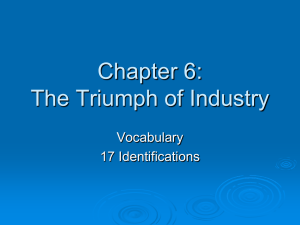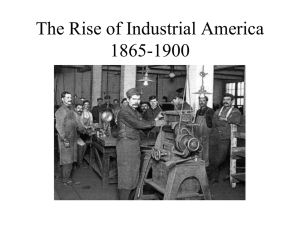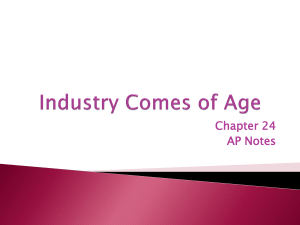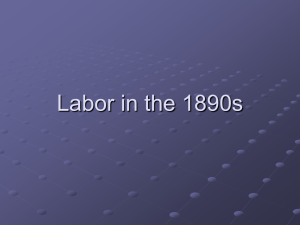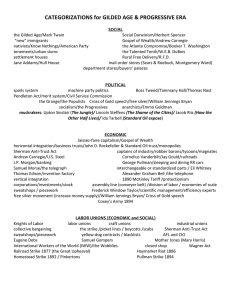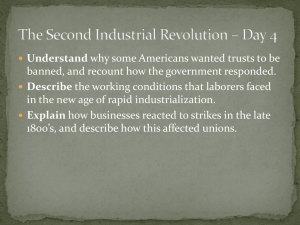industrialization
advertisement
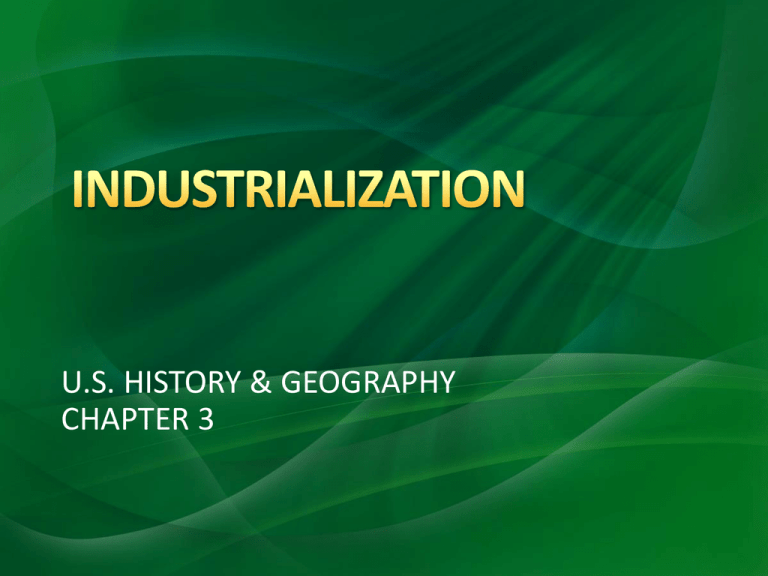
U.S. HISTORY & GEOGRAPHY CHAPTER 3 Second Industrial Revolution: occurs after Civil War Gross National Product (GNP): total value of goods & services that a country produces in a year Factors that spurred massive growth: Natural Resources – timber, iron, coal, copper, & petroleum (kerosene first then gasoline) – SEE MAP PG. 93 Government support for business Urban population Markets for new products air is injected into molten iron to remove the carbon & other impurities produces steel Henry Bessemer, English Engineer and Inventor, 19th century Electricity: Thomas Alva Edison. Communication: telegraph cable across Atlantic by Cyrus Field. Telephone by Alexander Graham bell 1876 Typewriter: Christopher Sholes 1867 Alternating Current (AC), air-brake system for railroads, hydroelectric power: George Westinghouse Ice Machine: Thaddeus Lowe – refrigeration Bell speaking into a prototype model of the telephone Laissez-faire: government should not interfere in the economy other than to protect rights & maintain peace. Supply & demand would regulate wages & prices, competition will promote efficiency & wealth Free Enterprise: little or no government regulation Entrepreneurs: risk capital to create, organize, & run businesses – SEE POLITICAL CARTOONS PG. 94 SEE MAP ON PGS. 90-91 & 98 Pacific Railway Act 1862: Union Pacific & Central Pacific were given permission & land to build 1st transcontinental railroad Offered Americans a NEW life Promontory Summit, Utah - May 10, 1869 TIME management Iron, coal, steel, lumber, & glass industries benefited from railroads’ demands George Pullman: created a town to build sleeper cars & other types of railroad cars George Pullman & his Pullman Town A construction company that would get contracts to lay track & charge 2x to 3x the actual cost, pocketing profits. Sold stock well below market value to members of Congress to get more grants/contracts – SEE POLITICAL CARTOON PG. 99 Domination of the economy through huge factories & distribution facilities SEE CHART PG. 101 Corporations Economies of scale Fixed costs Operating costs Andrew Carnegie: largest steel company in the world – Carnegie Steel Vertical integration & Horizontal integration – SEE CHART PG. 102 Social Darwinism: how Carnegie explained his success: hard work, shrewd investments, & innovative business tactics. Considered “natural law” – best adapted individuals survive "Forty-Millionaire Carnegie in his Great Double Role. As the tight-fisted employer he reduces wages that he may play philanthropist and give away libraries, etc." John D. Rockefeller: largest oil company – Standard Oil Used trusts to “join” all other oil companies together (horizontal integration) Rockefeller at one point will have a monopoly on the oil industry as he owned 90% Trusts Holding Companies Investment Banking Advertisement – N.W. Ayer & Son, 1st company, used large illustrative ads Shopping centers – Cleveland 1890 Public transportation Departments stores & chain stores – Marshall Field, F.W. Woolworth Catalogs & free rural delivery – Montgomery Ward, Sears both which turned into stores as well Marshall Field F.W. Woolworth Used to assist workers in bargaining for higher wages & better working conditions Two basic types of workers: craft workers (skilled) & common laborers National Labor Union & Knights of Labor – earliest unions formed SEE CHART PG. 106 Employers felt that they were conspiracies Methods used to stop unions: Yellow-dog contracts Blacklist Lockouts Strikebreakers Marxism: Karl Marx. Basis for communism. Anarchism is the belief that government was not needed. Led to assassinations & revolts across Europe & eventually in U.S. B & O Railroad workers walked off the job protesting their 3rd wage cut. Eventually 80k workers across the country would strike causing disruptions in over 2/3 of the nation’s railways & $10 million damage to railroad property. Governors sent out militias & President Rutherford B. Hayes sent federal troops. Took 12 days to restore order. May 4, 1886 Laborers wanted an 8-hour workday, nationwide strike called for May 1. May 3 – Chicago police intervened in a fight on a picket line at McCormick Harvester Plant by opening fire on the strikers killing 4. May 4 – 3k people gathered at Haymarket Square to protest the police brutality. As crowd dispersed due to weather a bomb was thrown into the police line. Police fired. 3 speakers & 5 others were arrested & convicted. Carnegie Steel Plant – Homestead, PA Henry Frick (CEO) was cutting wages. Workers strike. Frick hires Pinkerton Detective agency to protect “scabs” (strikebreakers) to keep plant operating. Battle ensues as they arrived killing 3 detectives & 9 workers. PA National Guard restores orders. 4 months later strike collapsed. During the Homestead Strike of 1892, the Pinkertons killed 11 people while enforcing strikebreaking measures. Illustration in Harper's Weekly. Pullman lays of 3k workers & cuts wages of remaining workers. Eugene Debs of the American Railway Union asked for arbitration when economy improved, Pullman said no. Boycott of Pullman trains & cars followed. Pullman hires strikebreakers only to be met with violence as the strikers will now burn the Pullman cars. President Grover Cleveland sends in federal troops to keep mail running. Federal court issues an injunction to halt the boycott. Founded by Samuel Gompers. Encompasses laborers from specific craft unions together. Used collective bargaining to reach WRITTEN agreements. Three main goals: convince companies to recognize unions, push for closed shops, & promote an 8-hour workday Becomes the biggest union with over 500k members. Still exists today but is combined with the Congress of Industrial Organizations (CIO) in 1955. “Wooblies”. Headed by William Haywood. Used the ideals of socialism to govern the union. Members never topped 100k but included miners, lumberers, cannery, & dock workers, & African Americans. 1912: only successful strike for 25k textile workers in Lawrence, MA 18% of workforce. Mostly in: domestic servants, teachers, nurses, sales clerks, clerical workers, garment industry, & food processing plants. Would organize their movements. International Ladies Garment Workers Union founded by Pauline Newman: 1909 won better wages & benefits for employees with a strike of 30k workers Women’s Trade Union League founded by Mary Kenney O’Sullivan & Leonora O’Reilly
